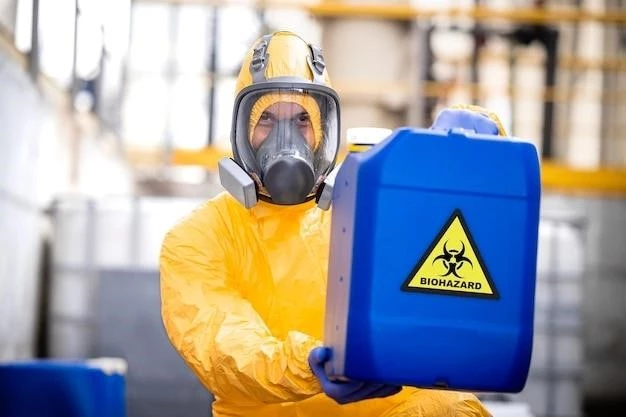Formaldehyde Poisoning
Formaldehyde poisoning is a serious health hazard resulting from exposure to this volatile chemical․ Learn about the dangers of contamination, toxicity, and the risks it poses to respiratory health․ Understanding the symptoms and prevention methods are crucial in safeguarding your health․
Understanding Formaldehyde Poisoning
Formaldehyde is a chemical widely used in various industries, such as manufacturing, healthcare, and construction․ Exposure to formaldehyde can occur through inhalation, ingestion, or skin contact, leading to formaldehyde poisoning․ This chemical is classified as a carcinogen, meaning it has the potential to cause cancer with long-term exposure․
Indoor air pollution is a common source of formaldehyde, with furniture, flooring, and household products releasing the chemical into the air․ Symptoms of formaldehyde poisoning can range from mild irritation to severe respiratory issues․ It’s crucial to be aware of the sources of formaldehyde in your surroundings and take steps to minimize exposure․
Occupational settings pose a significant risk of formaldehyde exposure, especially in industries where formaldehyde is used in large quantities․ Adhering to safety regulations and wearing appropriate protective gear is essential in preventing formaldehyde poisoning in the workplace․ Understanding the health hazards associated with formaldehyde is key to protecting yourself and others from its harmful effects․
Symptoms of Formaldehyde Poisoning
Recognizing the symptoms of formaldehyde poisoning is crucial for early detection and treatment․ Initial signs may include eye, nose, and throat irritation, coughing, and difficulty breathing․ Prolonged exposure can lead to more severe symptoms such as chest tightness, wheezing, and respiratory distress․
Other symptoms of formaldehyde poisoning may manifest as skin rashes, headaches, nausea, and dizziness․ In severe cases, it can result in damage to the central nervous system and even organ failure․ If you experience any of these symptoms after potential exposure to formaldehyde, seek medical help immediately․
It’s important to note that individuals with pre-existing respiratory conditions or compromised immune systems may be more susceptible to the effects of formaldehyde poisoning․ Taking preventative measures to reduce exposure and understanding the signs of poisoning are key to safeguarding your health and well-being․
Occupational Risks and Regulations
Occupational exposure to formaldehyde poses significant health risks to workers in industries where this chemical is commonly used․ Employers have a legal obligation to protect employees from formaldehyde hazards by implementing safety regulations and providing proper training․
Workers in facilities that manufacture or use products containing formaldehyde, such as laboratories, mortuaries, and wood processing plants, are at higher risk of exposure․ It is essential for employers to conduct regular assessments of formaldehyde levels in the workplace and take necessary measures to control contamination․
Occupational safety guidelines recommend the use of personal protective equipment, such as respirators and protective clothing, when working with formaldehyde․ Proper ventilation systems and engineering controls should be in place to minimize exposure and ensure a safe working environment․
Employees should receive training on the hazards of formaldehyde, proper handling procedures, and emergency protocols in case of exposure․ Reporting any suspected leaks or spills promptly can prevent potential health risks and ensure a healthier workplace for all․ Compliance with safety regulations is vital in reducing the incidence of formaldehyde poisoning among workers․
Formaldehyde as a Carcinogen
Formaldehyde is classified as a carcinogen, meaning it has the potential to cause cancer in humans․ Prolonged exposure to formaldehyde has been linked to an increased risk of developing certain types of cancer, particularly in the nasal cavity and throat․
Individuals working in occupations where formaldehyde exposure is common, such as embalmers, laboratory technicians, and industrial workers, are at a higher risk of developing cancer due to long-term exposure to this chemical․ It is essential for these individuals to adhere to safety regulations and practices to minimize their risk․
Studies have shown that formaldehyde can damage the DNA in cells, leading to mutations that may result in the development of cancerous tumors․ Understanding the carcinogenic properties of formaldehyde underscores the importance of taking proactive steps to limit exposure and protect your health․
Regular monitoring of formaldehyde levels in the environment, proper ventilation systems, and the use of personal protective equipment are crucial in reducing the risk of formaldehyde-related cancers․ By following safety guidelines and minimizing exposure, individuals can lower their chances of developing cancer due to formaldehyde exposure․
Indoor Air Pollution and Formaldehyde
Indoor air pollution is a significant source of formaldehyde exposure in homes and workplaces․ Common household items such as furniture, carpeting, and cleaning products can release formaldehyde gas into the air, leading to potential health hazards․
Improper ventilation and airtight spaces can exacerbate indoor air pollution, allowing formaldehyde levels to build up over time․ This can result in symptoms of formaldehyde poisoning, including respiratory irritation, headaches, and dizziness․
To reduce the risk of formaldehyde exposure indoors, it is important to choose products with low formaldehyde emissions, ensure proper ventilation by opening windows or using air purifiers, and avoid smoking inside buildings․ Regularly airing out indoor spaces can help dissipate formaldehyde and improve air quality․
Testing indoor air quality for formaldehyde levels can also provide valuable information on potential exposure risks․ By being mindful of indoor air pollution sources and taking proactive steps to minimize formaldehyde emissions, individuals can create a healthier living and working environment for themselves and their families․
Respiratory and Irritation Effects
Exposure to formaldehyde can have severe respiratory and irritation effects on the body․ Inhalation of formaldehyde vapors can cause irritation to the eyes, nose, and throat, leading to symptoms such as burning sensations, coughing, and a sore throat․
Prolonged or high levels of exposure to formaldehyde can result in more serious respiratory issues, including difficulty breathing, chest tightness, and exacerbation of asthma symptoms․ Individuals with respiratory conditions may experience worsened symptoms when exposed to formaldehyde․
Additionally, skin contact with formaldehyde can cause irritation, redness, and dermatitis․ Those sensitive to formaldehyde may develop allergic reactions on the skin, leading to discomfort and inflammation․ It is crucial to avoid direct contact with formaldehyde-containing products and materials to prevent these skin irritations․
Protecting yourself from formaldehyde exposure by wearing appropriate personal protective equipment, ensuring proper ventilation in indoor spaces, and reducing contact with formaldehyde-emitting products can help minimize the risk of respiratory and skin irritation effects․ Being vigilant about potential sources of formaldehyde in your surroundings is key to maintaining optimal health and well-being․
Treatment and Prevention of Formaldehyde Poisoning
Seeking prompt medical attention is crucial if you suspect formaldehyde poisoning․ Treatment may involve removing the individual from the contaminated environment, administering oxygen therapy, and providing supportive care to manage symptoms․
Prevention is key in avoiding formaldehyde poisoning․ Minimize exposure by using formaldehyde-free products whenever possible, improving ventilation in indoor spaces, and following safety guidelines when working with formaldehyde-containing materials․
Regular monitoring of indoor air quality, especially in areas with potential formaldehyde sources, can help identify and address contamination issues early on․ Educate yourself and others about the risks of formaldehyde exposure to promote a safe and healthy environment․
By adopting preventive measures, staying informed about formaldehyde hazards, and taking appropriate actions to reduce exposure, you can protect yourself and your loved ones from the harmful effects of formaldehyde poisoning․ Prioritizing safety and health is essential in mitigating the risks associated with formaldehyde exposure․

